Ask anyone where the supercar capital of the world is and they'll likely point you towards Italy. But that's not the only place where supercars are born. Nor is it – despite the best efforts of Ferrari – home to the bulk of grand prix victories and world championships. Those bragging rights belong to a section of England we call Carbon Fiber Valley. It's where you'll find the majority of Formula One teams and suppliers, and at its heart lies the sleepy town of Woking.
With a little over 60,000 inhabitants, Woking wouldn't register on most radars. But it blips big on ours thanks to the McLaren Technology Centre, home to one of the most successful teams in F1 history and a supercar manufacturer to rival Italy's best. It's one of the great gearhead meccas of the world. So on our last visit to the UK we took a stroll along the boulevard of McLaren history.
Hidden on more than a hundred green acres at the outskirts of Woking lies a space-age complex designed by Norman Foster, one of Britain's preeminent architects. Both inside and out, it could double as a super-villain's lair in most any fantastical action movie.
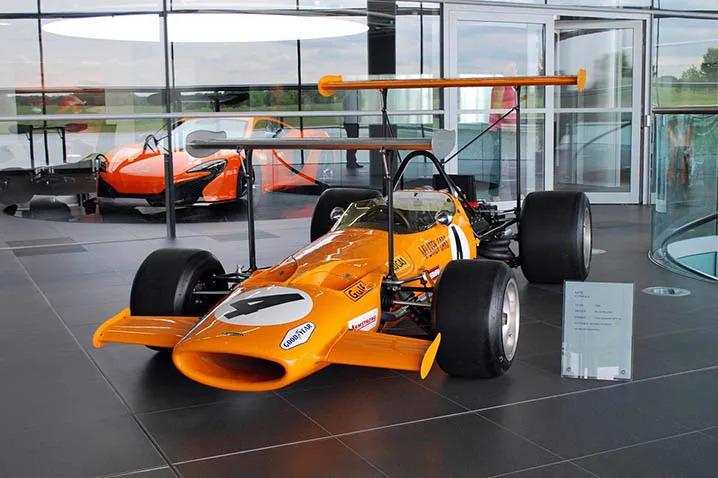
The McLaren Technology Centre (MTC) opened in 2003. The campus grew with the addition of the McLaren Production Centre (MPC) in 2011, and other facilities that are in the works. MTC hugs one of four artificial lakes that help cool the building and the adjoining wind tunnel. The entire building is pristine, everything above ground in glass and metal, everything below well-lit and lined with white panels. It's an embodiment of the McLaren ethos and the manifestation of chairman Ron Dennis' notorious obsession with detail. The cafeteria, for example, has lower air pressure than the rest of the building, so that smells don't escape into the hallway. Walking around, you get the feeling the entire structure could at any moment rise from the ground and rocket off into space.
The story is just as impressive at the adjacent MPC where technicians assemble the 650S, P1, and the forthcoming Sports Series. If things were any cleaner, less cluttered, or more spotlessly sterile, you'd think you were in an operating room. Unfortunately, photography of the assembly facility is prohibited, but that's just as well, because what we really came to see was the Boulevard.
While most F1 teams sell or scrap their used cars, McLaren keeps the vast majority of its own. (At least, it has since Dennis took over in 1981.) Most are stored in a nearby warehouse, and many have been dispatched to serve as centerpieces in showrooms around the world. But some of the finest examples of McLaren's victorious history form part of a rotating exhibit at the center of the MTC.
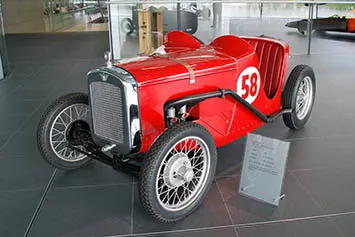
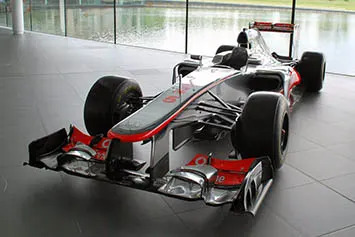

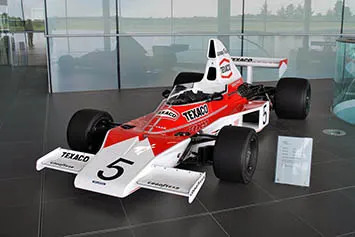
Our journey (and McLaren's) started with the 1929 Austin 7 in which Bruce McLaren won his first race in 1954 at the tender age of 15. His father bought the car in pieces with plans to sell it, but Bruce convinced him to keep it instead. They built the car together, along with a figure-eight track on which Bruce learned to drive. It was the start of a legendary career as both a driver and constructor of racing cars.
Sitting across from the Austin and bookending the other end of McLaren's history is the MP4-27 that Jenson Button drove in 2012. Button won three races that season, his teammate Lewis Hamilton another four, marking the team's last race wins to date.
Just beyond lies a dramatic 1969 McLaren M7C with more wings than a chicken joint. Bruce drove it himself until the guillotine front wing was banned. Close by, we see Emerson Fittipaldi's 1974 world championship car, the Texaco-liveried M23. That car won the first of many titles McLaren would accrue over the years, but we were more interested in the orange wedge parked adjacent.

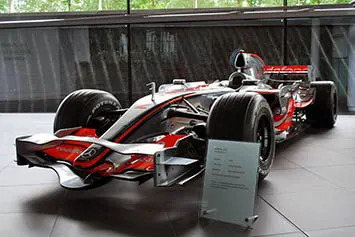
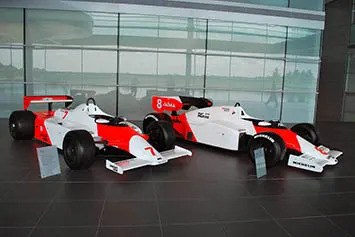
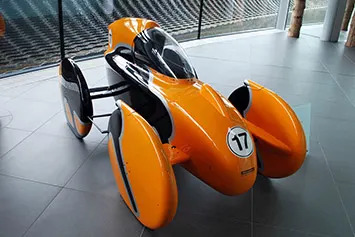
Can-Am was one of the most insane racing series ever devised, and McLaren positively dominated it, winning the championship five years running. This is the M8D with which Denny Hulme took top honors in 1970, winning six out of ten rounds that season as additional McLarens won another three. Hulme also drove for McLaren in F1, winning the '72 South African GP in the M19A before switching to this newer, Yardley-sponsored M19C, taking several more podiums before the season was over.
McLaren entered the Marlboro era soon thereafter. The original MP4 (named for the merger of McLaren and Dennis' Project 4 team) won just one race in '81, but its influence was far greater: the MP4 pioneered carbon-fiber construction, long before any other team adopted the lightweight material. Alongside it sits the MP4-2 in which Niki Lauda won the F1 championship in '84 under TAG-Porsche power, just half a point ahead of teammate Alain Prost. Though these cars long predate the ban on tobacco advertising, bureaucrats mandated the removal of their Marlboro logos. Same goes for the West logos from the Hakkinen-era cars that lay just beyond (but are too close to secretive workshops to allow for photography).
Past the display case where McLaren keeps every trophy it's ever won lay two more gems. Hamilton made his debut in this MP4-22, winning the 2007 Canadian GP en route to a four-win season and nearly taking the title. Alongside it sits the MP4-T5 in which chief test driver Chris Goodwin won the 2002 Goodwood Soapbox Challenge, setting a record in the process in this unpowered streamliner. It's a fitting end to a tour that started with the humble Austin and features some of the fastest automobiles ever devised, set against a backdrop more impressive than any we could imagine.
Related Video:
With a little over 60,000 inhabitants, Woking wouldn't register on most radars. But it blips big on ours thanks to the McLaren Technology Centre, home to one of the most successful teams in F1 history and a supercar manufacturer to rival Italy's best. It's one of the great gearhead meccas of the world. So on our last visit to the UK we took a stroll along the boulevard of McLaren history.
Hidden on more than a hundred green acres at the outskirts of Woking lies a space-age complex designed by Norman Foster, one of Britain's preeminent architects. Both inside and out, it could double as a super-villain's lair in most any fantastical action movie.

The McLaren Technology Centre (MTC) opened in 2003. The campus grew with the addition of the McLaren Production Centre (MPC) in 2011, and other facilities that are in the works. MTC hugs one of four artificial lakes that help cool the building and the adjoining wind tunnel. The entire building is pristine, everything above ground in glass and metal, everything below well-lit and lined with white panels. It's an embodiment of the McLaren ethos and the manifestation of chairman Ron Dennis' notorious obsession with detail. The cafeteria, for example, has lower air pressure than the rest of the building, so that smells don't escape into the hallway. Walking around, you get the feeling the entire structure could at any moment rise from the ground and rocket off into space.
The story is just as impressive at the adjacent MPC where technicians assemble the 650S, P1, and the forthcoming Sports Series. If things were any cleaner, less cluttered, or more spotlessly sterile, you'd think you were in an operating room. Unfortunately, photography of the assembly facility is prohibited, but that's just as well, because what we really came to see was the Boulevard.
While most F1 teams sell or scrap their used cars, McLaren keeps the vast majority of its own. (At least, it has since Dennis took over in 1981.) Most are stored in a nearby warehouse, and many have been dispatched to serve as centerpieces in showrooms around the world. But some of the finest examples of McLaren's victorious history form part of a rotating exhibit at the center of the MTC.




Our journey (and McLaren's) started with the 1929 Austin 7 in which Bruce McLaren won his first race in 1954 at the tender age of 15. His father bought the car in pieces with plans to sell it, but Bruce convinced him to keep it instead. They built the car together, along with a figure-eight track on which Bruce learned to drive. It was the start of a legendary career as both a driver and constructor of racing cars.
Sitting across from the Austin and bookending the other end of McLaren's history is the MP4-27 that Jenson Button drove in 2012. Button won three races that season, his teammate Lewis Hamilton another four, marking the team's last race wins to date.
Just beyond lies a dramatic 1969 McLaren M7C with more wings than a chicken joint. Bruce drove it himself until the guillotine front wing was banned. Close by, we see Emerson Fittipaldi's 1974 world championship car, the Texaco-liveried M23. That car won the first of many titles McLaren would accrue over the years, but we were more interested in the orange wedge parked adjacent.




Can-Am was one of the most insane racing series ever devised, and McLaren positively dominated it, winning the championship five years running. This is the M8D with which Denny Hulme took top honors in 1970, winning six out of ten rounds that season as additional McLarens won another three. Hulme also drove for McLaren in F1, winning the '72 South African GP in the M19A before switching to this newer, Yardley-sponsored M19C, taking several more podiums before the season was over.
McLaren entered the Marlboro era soon thereafter. The original MP4 (named for the merger of McLaren and Dennis' Project 4 team) won just one race in '81, but its influence was far greater: the MP4 pioneered carbon-fiber construction, long before any other team adopted the lightweight material. Alongside it sits the MP4-2 in which Niki Lauda won the F1 championship in '84 under TAG-Porsche power, just half a point ahead of teammate Alain Prost. Though these cars long predate the ban on tobacco advertising, bureaucrats mandated the removal of their Marlboro logos. Same goes for the West logos from the Hakkinen-era cars that lay just beyond (but are too close to secretive workshops to allow for photography).
Past the display case where McLaren keeps every trophy it's ever won lay two more gems. Hamilton made his debut in this MP4-22, winning the 2007 Canadian GP en route to a four-win season and nearly taking the title. Alongside it sits the MP4-T5 in which chief test driver Chris Goodwin won the 2002 Goodwood Soapbox Challenge, setting a record in the process in this unpowered streamliner. It's a fitting end to a tour that started with the humble Austin and features some of the fastest automobiles ever devised, set against a backdrop more impressive than any we could imagine.
Related Video:
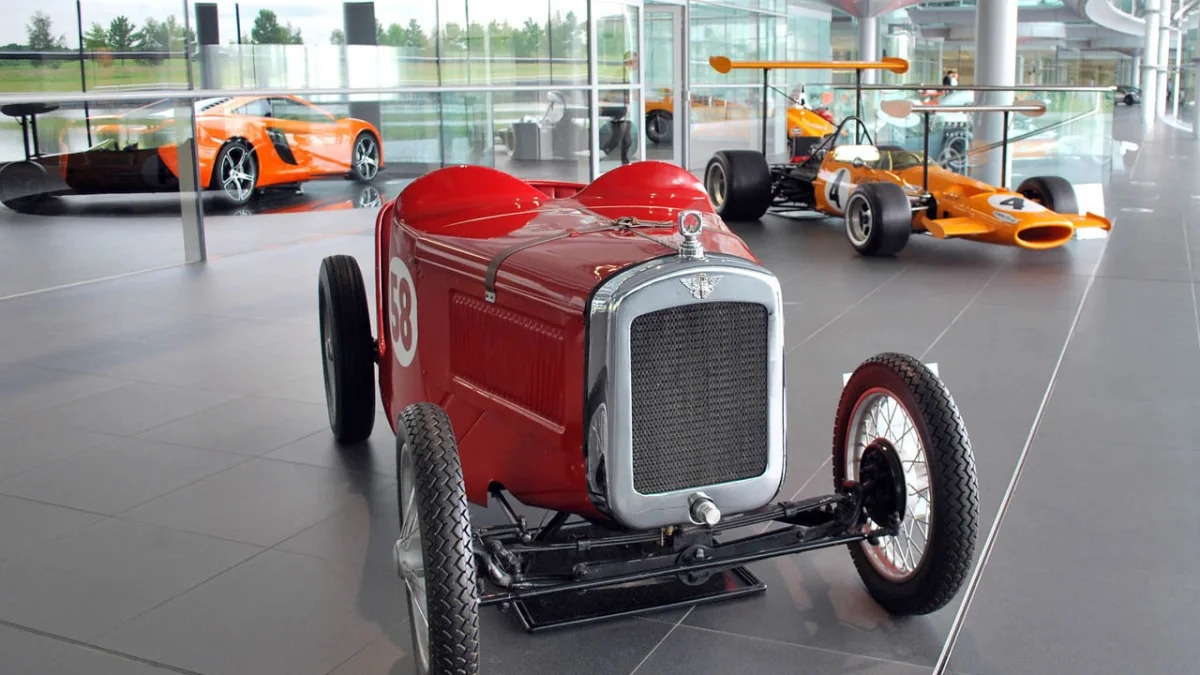









Sign in to post
Please sign in to leave a comment.
Continue